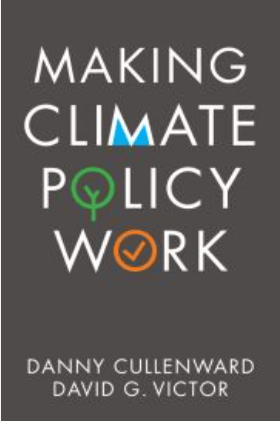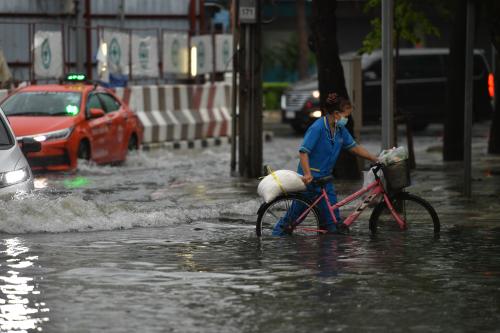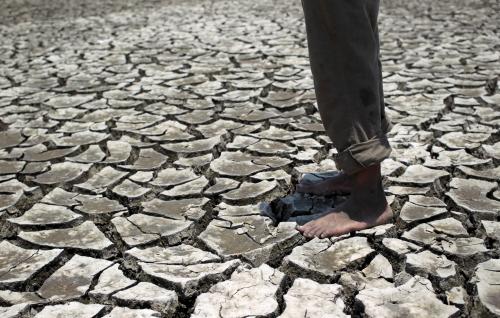The ongoing policy discussions about climate change resilience and the role of prevention and insurance, including the recent blog by Matthew Kahn and Somik Lall, reminded me of the 1985 science fiction movie “Back to the Future,” where a teenager is accidentally sent three decades back in a time-traveling automobile built by his eccentric scientist friend “Doc” Brown. It may be indeed worthwhile to go back to the future and return to the foundations of the economics of risk and insurance because some fundamental concepts developed more than half a century ago may be still very relevant to inform policy actions on climate change resilience.
The 50-year-old economic framework can offer some forward-looking insights on how individuals or households behave when confronted with climate shocks, the interactions between risk prevention and market insurance, and the market-enhancing role of government, especially when insurance markets are incomplete.
One of those seminal economic papers was published in 1972 by Isaac Ehrlich and Nobel laureate Gary Becker. In it they analyze how a risk-averse individual with a “risky” asset or wealth, such as a house exposed to floods, should determine their optimal mix of preventive investments that allows them to (i) reduce the magnitude of their potential loss (self-insurance), and/or (ii) reduce the probability of their loss occurring in the first place (self-protection) and/or (iii) purchase market insurance. In the context of climate change, self-insurance investments include building houses on stilts to protect them against floods, self-protection investments include migrating away from disaster-prone areas, and market insurance includes catastrophe risk insurance programs.
The individual decisions on optimal preventive investments to protect a risky asset can be reexamined using the concept of “riskiness” defined by Michael Rothschild and Nobel laureate Joseph Stiglitz in their 1970 seminal paper on increasing risk. Using the Rothschild-Stiglitz definition of “riskiness,” self-insurance and market insurance unambiguously reduce the “riskiness” of the asset by transferring wealth from good states of the world (when no loss occurs) to bad states of the world (when a loss occurs). On the contrary, an increase in self-protection investment may increase the “riskiness” of the asset: Self-protection can make a risk-averse individual worse off if the disaster loss still occurs because the individual not only experiences the disaster loss but has also paid a higher cost for self-protection. The concept of “riskiness” also explains why more risk-averse individuals invest more in self-insurance and market insurance but may invest less in self-protection.
The interactions between those preventive investments can be reexamined in light of their impact on the risky asset and allow us to re-interpret the two fundamental results of Ehrlich and Becker: Market insurance and self-insurance are substitute because they both contribute to reducing the “riskiness” of the asset; their optimal combination depends on their respective (shadow) price. This means that an increase in insurance coverage, for example, as a result of insurance premium subsidies, will reduce investments in self-insurance. On the contrary, market-insurance and self-protection can be complements: While market insurance makes the asset less risky, self-protection can increase its “riskiness.” This means that an increase in insurance coverage may induce increased investments in self-protection.
But what if the insurance market is incomplete? Let’s assume for example that there is a (uninsurable) risk that the insurance company does not pay its claims. This risk of insurance being nonreliable may be because the insurance company goes bankrupt or because of litigation with the settlement of the claims. During the COVID-19 pandemics for example, businesses and insurers went to court battles over whether insurers have to pay out claims over business interruptions as a result of the pandemic. Using Rothschild-Stiglitz’s definition of “riskiness,” nonreliable insurance does not always reduce the “riskiness” of the asset: The insured individual is worse off when the disaster loss occurs because she does not receive her insurance payouts while she had paid her insurance premium. This means that, when the insurance market is incomplete, self-insurance and nonreliable insurance can be complements. This potential complementarity means that an increase in (nonreliable) insurance coverage may lead to an increase in self-insurance investments. In other words, the insured individual may over-invest in self-insurance to mitigate the risk of market insurance being nonreliable. This is an inefficient use of self-insurance caused by insurance market imperfections.
Figure 1. Self-insurance and (non)reliable insurance as substitutes (complements)
 Source: Author.
Source: Author.
This simple framework that builds on economic concepts developed more than five decades ago can provide some insights for public policy to strengthen financial markets for improved climate change resilience when insurance markets are incomplete. The complementarity between self-insurance and nonreliable insurance is clearly an inefficient allocation of resources due to incomplete insurance markets. There is therefore a rationale for public intervention and policy reforms to help correct these market imperfections. Prudential regulation of insurance markets, for example through solvency capital requirements that account for climate risks and other systemic risks like pandemics, can help improve the soundness of insurance companies’ operations. Likewise, the establishment of (government-sponsored) insurance guarantee schemes can protect the insureds when insurers are unable to fulfill their contractual commitments. Resilient financial markets will ensure that both market insurance and self-insurance, as substitute investments, maximize their synergy and contribute to improving the resilience of countries, communities, and people against climate shocks.








Commentary
Back to the future: Climate change resilience, self-insurance, and market insurance
December 6, 2021